Continuing the series of posts showing work taken in London in 1979 as posted to Facebook with comments an image at a time in the first half of 2018.
Previous post in London 1979 series
______________________________________________________
London Photographs 1979 – Peter Marshall
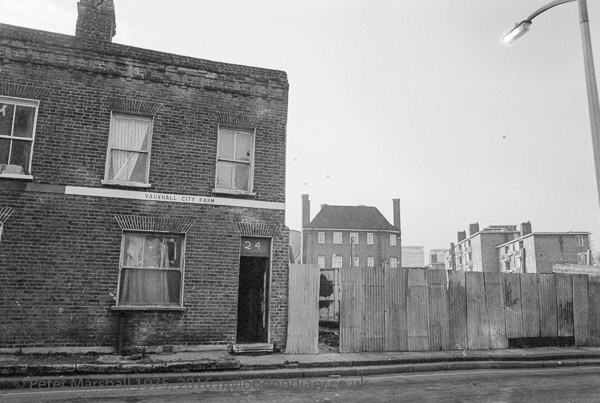
Vauxhall City Farm, Vauxhall, Lambeth 1979
18u-64: house, city farm, fence,
This was the original entrance in St Oswald’s Place and was replaced by a new building in 2015. I think the street was fairly narrow and for once the tilt of the camera was deliberate.
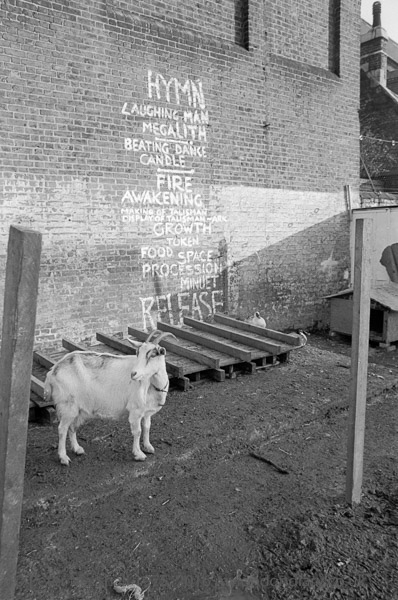
Hymn and goat, Vauxhall City Farm, Vauxhall, Lambeth 1979
18u-65: house, city farm, fence,
The farm had been tidied up since my visit ten months earlier – even the goat looks better groomed. The ‘HYMN’ was still there on the wall.
The contact sheet tells me that I took this and the previous image on 27th January, working with my Olympus OM1 and even details the development (D76 diluted 1:1 9 mins) which seems fairly short. The film was Kodak Safety film 5063 better known as Kodak TRI-X Pan Film.
Many photographers, particularly amateur photographers, using film spent long years experimenting with different developers, times and dilutions and exposure ratings, particularly those who got caught up in worshipping Ansel Adams and his Zone System. I dabbled a little, though you could only be a true aficionado if you used sheet film and exposed and developed each exposure separately depending on the lighting conditions. But using 35mm there were some compromises, particularly if a film was exposed under different lighting conditions and perhaps over several days or weeks. But many of us learnt to base exposures on shadow detail (using spot metering when time allowed) and tried to develop for the highlights. When the Olympus OM4 came out in 1983 it’s metering system made placing the shadows rather easier.
Different developers had different effects on film too, and different dilutions altered these. Some gave finer grain by dissolving some of the image, while others gave increased sharpness by edge effects (acutance.) Some enabled you to increase developing times while increasing the density of the darker areas of the negative less than others, enabling you to ‘push’ films, exposing them at higher film speed settings on camera or meter.
Developers varied from the bog-standard neat D76 favoured in the deep tanks in many professional darkrooms and regularly replenished as film after film went through to esoteric magic formulae sold in ampoules opened and diluted immediately before single use. Over the years I used quite a range of them, making some up myself from the ‘raw chemicals’, and publications such as the British Journal of Photography Annual used to have a selection of photographic formulae in their end pages.
My various experiments taught me several things, particularly that some developers were more reliable than others. One I used for some time enabled me to rate Tri-X at ASA2000, under-exposing over two stops, and produce prints from 35mm that led one club judge to comment that “it’s good to see that some ‘workers’ are still using medium format”. But I gave it up as sometimes films would come out with densities too low to be printable for no apparent reason. D76 was dependable, diluting it with equal amounts of water for single use solved any problems of deterioration with infrequent use, and also gave a slight increase in sharpness by reducing its solvent effect, and bought in bulk it was cheap.
Later I more or less standardised development, and much of my later black and white photography was in any case using chromogenic films developed in the standard C41 developer.
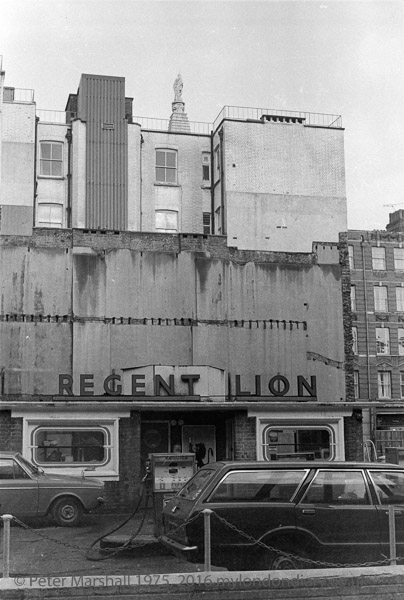
Regent Lion Filling Station, Coptic St, Camden, 1979
19c-16: house, petrol, filling station, Islington
Rising at the top of the picture is the unmistakable tower of St George’s Bloomsbury, but I had long forgotten the exact location of the Regent Lion Filling Station. I took it as the first of four frames before getting to St Chad’s St in the area to the south of King’s Cross, and I had long thought this picture must have been near there.
But I had walked some distance with the Leica M2 around my neck, and that this picture was taken on Coptic St, just to the south of the British Museum. Though the petrol pumps and the building above them have long gone, the building at the right edge of the picture is still recognisable on the corner of Museum St and Bloomsbury Way.
The company was incorporated in 1955 and appears to have been dissolved some time in the 1990s. The Regent trademark had a long history in petrol outlets, beginning with Burt Boulton & Haywood, a small independent distributor who had a wharf and chemical works at Prince Regent’s Wharf which is now the Thames Barrier Park. They were bought up by Trinidad Leaseholds in 1930, and post war they merged with Texaco and later Caltex, reverting to Texaco in 1967, who discontinued the use of the brand name for most of the outlets, though it was revived for special uses in 2004. The Regent Oil Company were also on Canvey Island and the site changed its name to Texaco at some point but is now closed.
Regent were one of several companies who sold road maps under their name from the 1930s to the mid 1960s, though later these were sold as Texaco or Chevron (another Texaco brand).
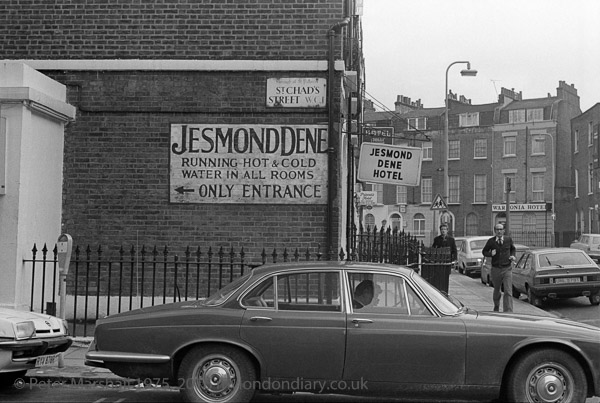
Hotel, St Chad’s St, Kings Cross, Camden, 1979
19d-15: house, hotel, cars
Little visibly has changed from when I took the picture, though parking is now more restricted and there are cycle lanes along St Chad’s St. The hotels have gone up a little in the world (and rather more in price) and look rather better cared for. The hotel sign is still there, but repainted with different text.
At the time this was London’s most celebrated red-light district, and a short walk away is Holy Cross, Cromer St, occupied by the English Collective of Prostitutes for 12 days in 1982 in a protest against intimidation and false arrests of prostitutes on the streets of the area by police under the 1959 Street Offences Act. Police were reported to be demanding free sex, demanding money, assaulting or beating up women and colluding with pimps to extract more money from the women.
The area – the Battle Bridge estate – went down in the world quickly after it was developed in the 1820s and 30s, with drunkenness and vagrancy common by the 1840s. When Kings Cross, Euston and St Pancras Station were built they brought in more people and more vice, both customers and prostitutes, some of whom were alleged in later years to commute to the area on ‘Have It Away Day’ tickets.
It was the arrival of drugs that really brought the area down, adding syringes to the local street detritus and fuelling both prostitution and petty crime by those desperate to feed their habits. Fast food too began to litter the streets, and in the 70s the area was probably at its lowest.
There were also huge development plans for the areas around Kings Cross, and later I became involved for several years with the King’s Cross Railway Lands Group, an independent community organisation that campaigned for 25 years until 2013 to “make sure that the people who live, work or study in the King’s Cross area are involved and benefit from its re-development.”
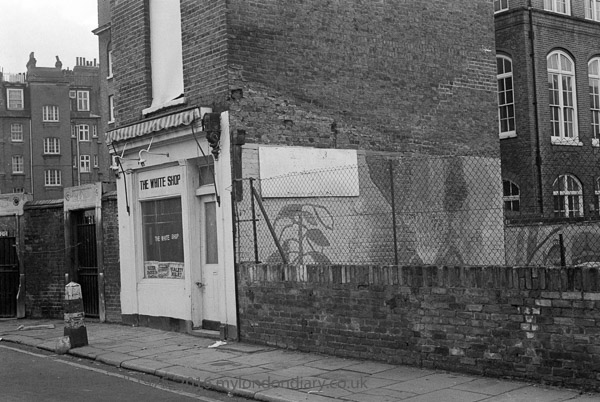
The White Shop, Whidborne St, Kings Cross, Camden, 1979
19d-21: shop, school, mural,
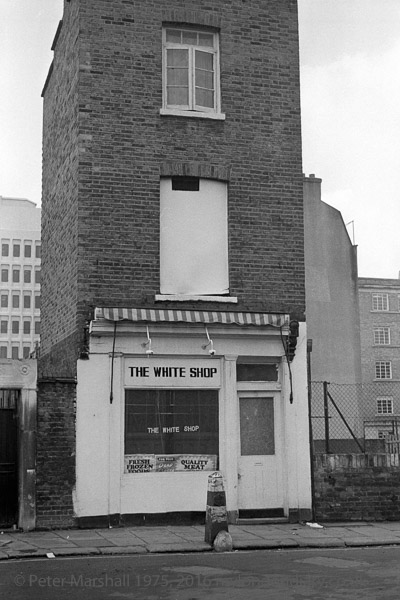
The White Shop, Whidborne St, Kings Cross, Camden, 1979
19d-24: workshop,
Whidborne St is a small street which links Argyle St which was part of the Battle Bridge estate of the 1830s to Cromer St in the area just south of St Pancras and Kings Cross stations, and this end of it north of Argyle Walk is something of a relic from the mid-nineteenth century, left when the slums of the Cromer St area were redeveloped by the East End Dwellings Company in the 1890s, some of whose tenements are at the left of the frame. The street it thought to have got its name from one of the directors of this company.
The White Shop at 6 Whidborne St is said to have been at one time the house of the headmistress of the Argyle Primary School which is at the right of the picture, though its small size and plain design makes it look more like a caretaker’s house. Two school entrances (not now in use) at the left of the shop are still present. The school was built as Manchester Street School (this part of Argyle St was known as Manchester St until some time in the early 20th century) in 1880 and later had links with Mary Ward and the 1897 Passmore Edwards Settlement in Tavistock Place which provided after-school activities for poor children until their parents left work.
The White Shop became a butcher’s shop “belonging to a Mr William Johnson” and when I photographed it in 1979 was still selling frozen foods and ‘Quality Meat’. It was converted into 2 flats in the 1990s, but later reverted to a single dwelling and plans for a rear extension and a mansard roof extension were passed in 2014. The conversion looks neat but the roof is rather out of character with the plain stock brick Victorian original.
Opposite, behind me as I took this picture was the Duke of Wellington public house, its address originally 33 Manchester St which became 5 Whidborne Street WC1. It has now become the Irish themed McGlynn’s.
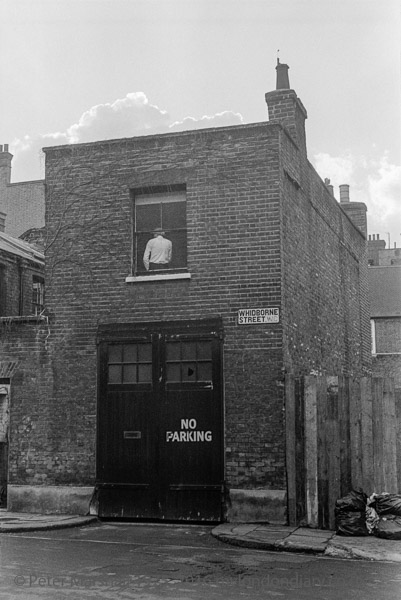
Whidborne St, Kings Cross, Camden, 1979
19d-22: workshop,
A man in a white shirt stands leaning his back against the first floor window of a small block-shaped building on Whidborne St, one of two similar blocks (the other is wider) with a narrow yard behind the brick wall between them. Both have wide doors to the street, either to admit a hand cart or on the other block a horse-drawn vehicle.
I think these were all premises of C E Norris & Sons, and across the top of the building at the south end of the yard (which I think I may have photographed in colour, but can’t currently find the slide) was the slightly misleading text:
C.E. NORRIS & SONS LTD
OFFICES – 73/5 KENTON ST. W.C.1
PHONE – TER. 4577
Kenton St is a short walk away, off Tavistock Place on the other side of Judd St, and the offices were separate from this complex which I assume was the builder’s yard for the private registered company, incorporated in 1932. Members of the Norris family appear to have resigned from the business in 1991 and it applied for and was granted voluntary striking off in 2001, but was restored in 2013 though it does not seem to have submitted returns or accounts to Companies House.
The properties are probably late Victorian and today seem little changed except in use. The street sign is Whidborne St, WC, and thus comes from before the introduction of sub-districts as a wartime measure to increase efficiency in 1917.
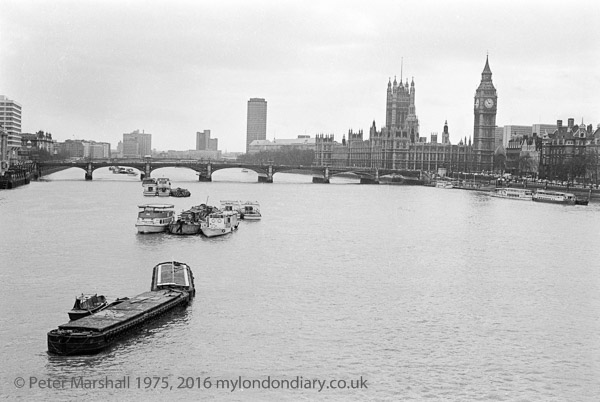
River Thames and Westminster Bridge, Westminster from temporary Hungerford Bridge, Westminster, 1979
19f-13: river, bridge, houses of parliament, offices,
This view is now one that we can see any day, but back in 1979 it was unusual, usually only glimpsed between the girders of Hungerford Bridge as your train rolled in or out of Charing Cross station. The Hungerford footbridge was only on the downstream side of the railway bridge, but in 1979 repairs were needed and it was closed and a temporary bridge built hanging to its upstream edge.
London’s skyline has changed considerably since 1979, particularly with new tall blocks along the riverside, but most of the buildings here are still present, though the cold store at Nine Elms has been replaced by other, even taller buildings.
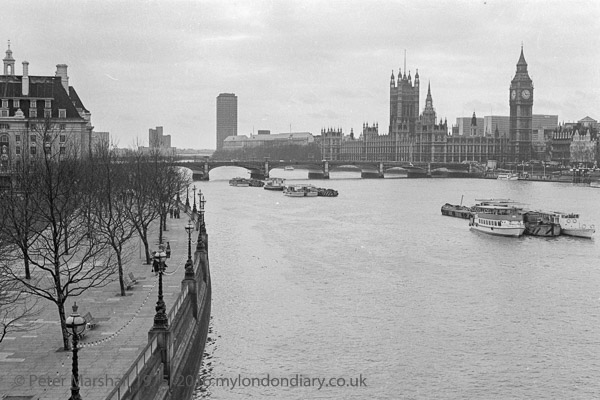
River Thames and Westminster Bridge, Westminster from temporary Hungerford Bridge, Westminster, 1979
19f-14: river, bridge, houses of parliament, offices,
A second picture, taken closer to the South Bank, shows the Embankment well before the London Eye. County Hall, then still occupied by the GLC, faced the Houses of Parliament across the river, a few years before Margaret Thatcher’s fit of pique put London’s government into disarray which the city has still not quite recovered from.
The boats moored in the river include the Chay Blyth, named after the first person to sail single-handed, non-stop westwards around the world in 1971, and now described as “one of the more traditional passenger boats operating on the Thames” but then relatively new, having been built in 1972 by Thomas W Hughan & Co Ltd at Point Wharf Greenwich, part of Delta Wharf just to the north of Victoria Deep Water Wharf. They built quite a few small vessels over the years, including many barges and apparently also the replica 1890’s Mississippi stern-wheeled Paddle Steamer Elizabethan. The company was dissolved in 1985.
______________________________________________________
More to follow shortly
Previous post in London 1979 series
______________________________________________________
The pictures in this series of posts are exactly those on London Photographs, where landscape format images display slightly larger. Clicking on any picture will go to the page with it on the web site.
I have included the file number and some keywords in the captions; you can order a print of any picture on this site using the file number.
Order details and prices
______________________________________________________
There are no adverts on this site and it receives no sponsorship, and I like to keep it that way. But it does take a considerable amount of my time and thought, and if you enjoy reading it, a small donation – perhaps the cost of a beer – would be appreciated.
My London Diary : London Photos : Hull : River Lea/Lee Valley : London’s Industrial Heritage
All photographs on this and my other sites, unless otherwise stated, are taken by and copyright of Peter Marshall, and are available for reproduction or can be bought as prints.
To order prints or reproduce images
________________________________________________________